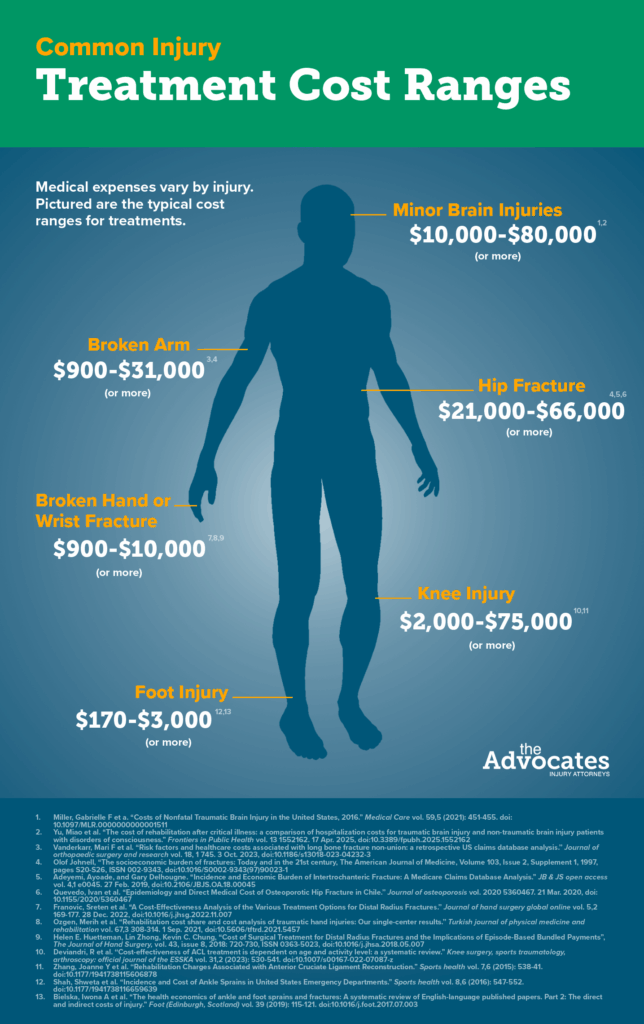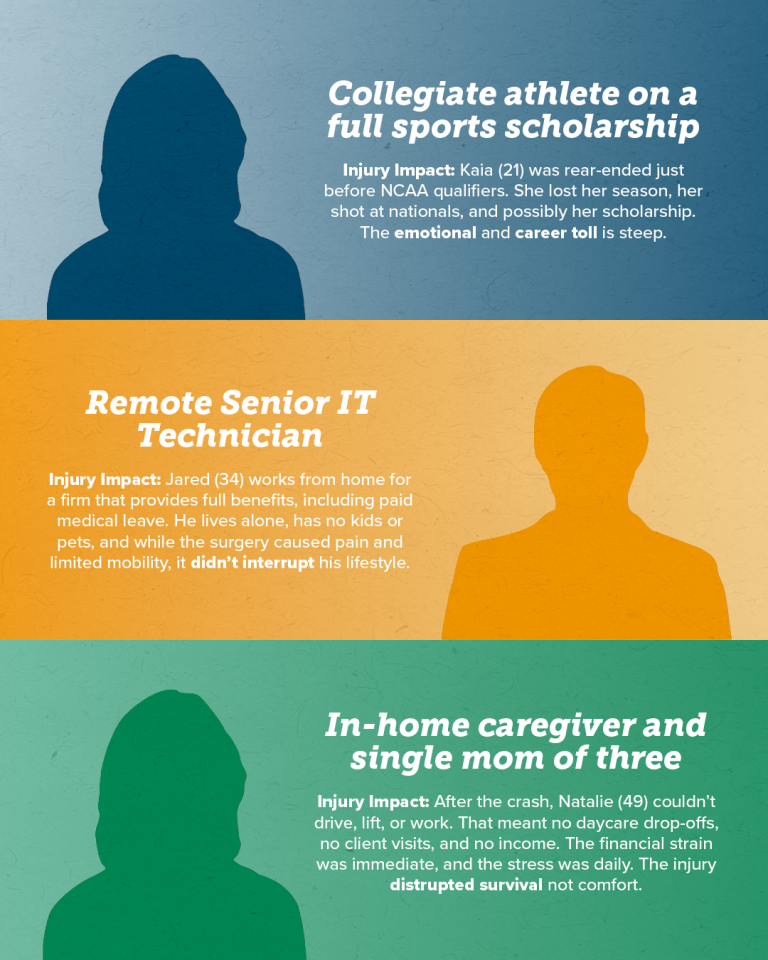
Online injury settlement calculators are everywhere. Type in a few numbers, and within seconds, you get a dollar estimate for your pain. But how consistent are these tools really? And, do your personal circumstances—your age, your job, your life—affect the result?
To find out, we ran an experiment. We used the exact same injury across different calculators: a wrist surgery costing $30,000, plus $10,000 in property damage. The only thing we changed? The person behind the injury.

Meet our 3 test subjects:
-
- Jared, 34 — Occupation: Remote Senior IT Technician (W-2 employee)
Injury Impact: Jared works from home for a tech firm that provides full benefits, including paid medical leave. He lives alone, has no kids or pets, and while the wrist surgery caused pain and limited mobility, it didn’t interrupt his lifestyle. He could order meals through delivery apps, book rides via rideshare services, and continue working remotely without issue. For him, the injury was temporary — not transformative.
-
- Kaia, 21 – Occupation: Collegiate athlete on a full sports scholarship
Injury Impact: Kaia was rear-ended just before NCAA qualifiers. She lost her season, her shot at nationals, and possibly her scholarship. The injury hit her at a critical moment in her athletic trajectory. She isn’t just recovering — she’s watching her future slip. With limited years to peak in sport, time is everything. The emotional and career toll is steep.
-
- Natalie, 49 — Occupation: In-home caregiver and single mom of three
Injury Impact: After the crash, Natalie couldn’t drive, lift, or work. That meant no daycare drop-offs, no client visits, and no income. She had to rely on neighbors to help with basic parenting tasks — diaper changes, bottle prep, groceries. The financial strain was immediate, and the stress was daily. For Natalie, the injury disrupted survival, not comfort.
Each one experienced the same accident, same medical bills, same property loss—but did the calculators treat them the same?
Some Considerations Before the Results
- The Multiplier Problem
As discussed in our article about how not all personal injuries are equal, many online calculators rely on a “multiplier” to estimate pain and suffering. First, the multiplier itself is subjective and varies across tools. Some only let you choose between whole numbers from 1 to 5. Others allow decimals like 1.5 or 4.5. That tiny difference can translate into tens or even hundreds of thousands of dollars.
Without a standard reference, people will input different values for the same experience based purely on personality or pain tolerance — not legal reasoning.
- Future Expenses: A Blind Spot
Some calculators ask you to estimate “future expenses” — but how? If you’re not a doctor or a financial analyst, you likely don’t know if your injury will worsen over time, or what adjustments you’ll need in your daily life.
Take Natalie, for example: beyond medical bills, she now has to spend more on help around the house, childcare workarounds, and simple daily logistics. These costs aren’t always top of mind — but they add up fast.
- Future Income: Unknowable for Some
Now consider Kaia. She’s only 21. How can she possibly calculate her future income loss when her entire athletic career could be impacted? She missed qualifiers, paused her training, and might lose her scholarship. A calculator asking her to enter a dollar amount here is asking too much. What if she had an outstanding career in sports? Many what ifs.
- No Scale for Mental Health
Most calculators include a “pain” score from 1 to 5, but only for physical suffering. What about mental health? Depression, anxiety, insomnia, and loss of enjoyment are real consequences of injury, but there’s no place to capture those. The result? A sanitized number that doesn’t reflect the full human cost.
- The ‘Nuisance Settlement’ Field
Some calculators ask for an estimated “nuisance settlement” — usually referring to small-dollar settlements offered just to avoid the cost of going to court. But many users haven’t reached that stage or don’t even know what the term means. Requiring this input skews the estimate and assumes a level of legal knowledge most people don’t have. That’s where an attorney would know better.
- Vague Ranges and Loose Buckets
Some calculators don’t let you input the actual amount of your bills. For example, if you paid $30,000 in medical care, it might just drop you into a “$25,000–$50,000” bucket. That’s a big range — and too broad to be precise.
- Errors (and Silent Confessions)
We saw one calculator say:
“Your settlement may range from $0–$0. We include a $0 floor to account for possible input errors.”
In other words: if you get this message, their system likely didn’t process your answers correctly — and they know it.
The Subjectivity Problem
Pain is personal — and so are the numbers people assign to it. When asked to rate their pain for the multiplier, each of our test subjects gave radically different answers based on personality, experience, and context. Kaia selected a 3. Why? A teammate of hers had recently suffered a far more traumatic injury, and she felt her situation didn’t compare. Jared, on the other hand, chose a 5. His pain tolerance is low, and even moderate discomfort disrupts his focus and daily routine. Then there’s Natalie. As a caregiver and single mom, she’s used to putting others first and staying strong. She marked a 1. Not because she wasn’t in pain — but because she didn’t want to overstate it.
Online Injury Calculators Differences
- Washington Private Law Firm
hellandlawgroup.com/personal-injury-calculator
-
-
-
- Localized for Washington State.
- Uses a multiplier system from 1 to 5.
- Includes a mandatory $1,000 “nuisance settlement” by default.
- Asks for 7 specific data points (mostly economic).
-
-
- Accident Values Calculator
-
-
-
- 6 financial questions, 12 medical-related, 5 accident-specific, 4 about context/location.
- Questions include whether airbags were deployed, whether you took an ambulance, and whether witnesses were present.
-
-
- Settlement Calculator
-
-
-
- Starts by asking your state.
- Focused on 5 financial and income-related questions.
- Uses a multiplier from 1 to 5, including half steps (like 2.5, 3.5)…
-
-
- AllLaw – Not Specific to Any State
alllaw.com/articles/nolo/personal-injury/calculator.html
-
-
-
- Uses a multiplier from 1.5 to 5, decimals included.
- Adds a $1,000 “nuisance settlement” by default.
- Asks for 6 financial entries.
- Only one to include non-economic damages like pain and suffering explicitly.
-
-
Results:
Kaia (21)
Washington Online Calculator: $93k
Settlement Calculator: $161k
Accidents Value: $76k
All Law: $131k
Jared (34)
Washington Online Calculator: $155k
Settlement Calculator: $241k
Accidents Value: $76k
All Law: $191k
Natalie (49)
Washington Online Calculator: $37k
Settlement Calculator: $93k
Accidents Value: $96.4k
All Law: $96k
What the Results Reveal
Despite reporting the exact same injury — a $30,000 wrist surgery and $10,000 in property damage — the estimated compensation for each subject varied significantly. The lowest estimate came in at $37,000, and the highest reached $241,000, depending solely on how each life intersected with the injury.
-
-
-
- Kaia (21) landed anywhere between $76K and $161K, despite facing one of the most devastating long-term setbacks. Her athletic career was just taking off, and this injury forced her to withdraw from competition, risking her scholarship and future sponsorships. Yet, none of the tools considered the lost trajectory of a sports career — a short-window opportunity that may never return. The emotional cost of watching a lifelong dream pause, or end, was also invisible in the results.
- Jared (34) saw a range between $76K and $241K. He marked his pain level as “high,” but his lifestyle allowed him to absorb the impact with relative ease: remote work, paid leave, no dependents, and the means to outsource his daily tasks. His estimates were the highest across the board — despite having the most stable life circumstances post-injury.
- Natalie (49) received results spanning $37K to $96K, and in some cases, her value was the lowest. Yet she arguably bears the heaviest daily burden. Unable to work or drive, raising three children alone, and lacking support, Natalie’s injury created a cascade of small, constant costs — childcare, mobility, household help — that were difficult to express in numbers. Her modest pain rating, rooted in resilience and experience, may have worked against her.
-
-
Do you like this article?
If you liked this article, you might like our others:
What car is best for you? What are the common safety standards that American cars do that Foreign Cars dont’t? We cover these topics and more in this article.
American vs. Foreign Cars: Safety Standards and What They Mean for You
Did you know that e bike and e-scooter accidents are on the rise? Do you know by how much? It’s a lot. Check out our article here:
Micro Mobility Vehicle Accidents on Historic Rise
Can AI like ChatGPT Calculate My Injury Claim’s Value?
While ChatGPT can help you estimate your injury claim by asking a series of questions, it’s important to understand that its calculations are based on general averages and patterns. It’s not designed to grasp the nuances of your specific situation, like how your injury might impact your daily life, job, or mental health. The AI pulls from broad data sets, which means it can only give you a rough estimate that might not reflect your actual needs or future losses.
In short, ChatGPT works with averages, but real-life situations often require more personalized attention. And guess what? The source for all this…is ChatGPT itself.
Even AI will tell you it’s just a starting point—not the final word on your claim.
Watch Out: Not All “Injury Calculators” Are Real
Some so-called calculators are just data traps—forms designed to collect your info for law firm databases. You’re not getting an estimate; you’re just triggering a follow-up email or phone call.
Red Flags For “Lead Generators”
-
-
-
- The calculator contains a big text box asking you to, “describe what happened.”(Can’t calculate values from anecdotal elements alone.)
- The calculator only loads once you’ve entered contact information.
- The calculator asks for personal financial information.
-
-
Final Thoughts: Same Injury, Different Lives
What these tests made painfully clear is that injury calculators are not equipped to understand context. They ask for numbers — medical bills, days missed, pain scores — but they can’t measure missed dreams, daily chaos, or the quiet cost of holding everything together.
A settlement is about what it truly costs to get your life back. And that’s something only real human evaluation — not an algorithm — can begin to understand.
Talk to us today. Free consultations, no hidden fees, no catch. Just a real conversation.
